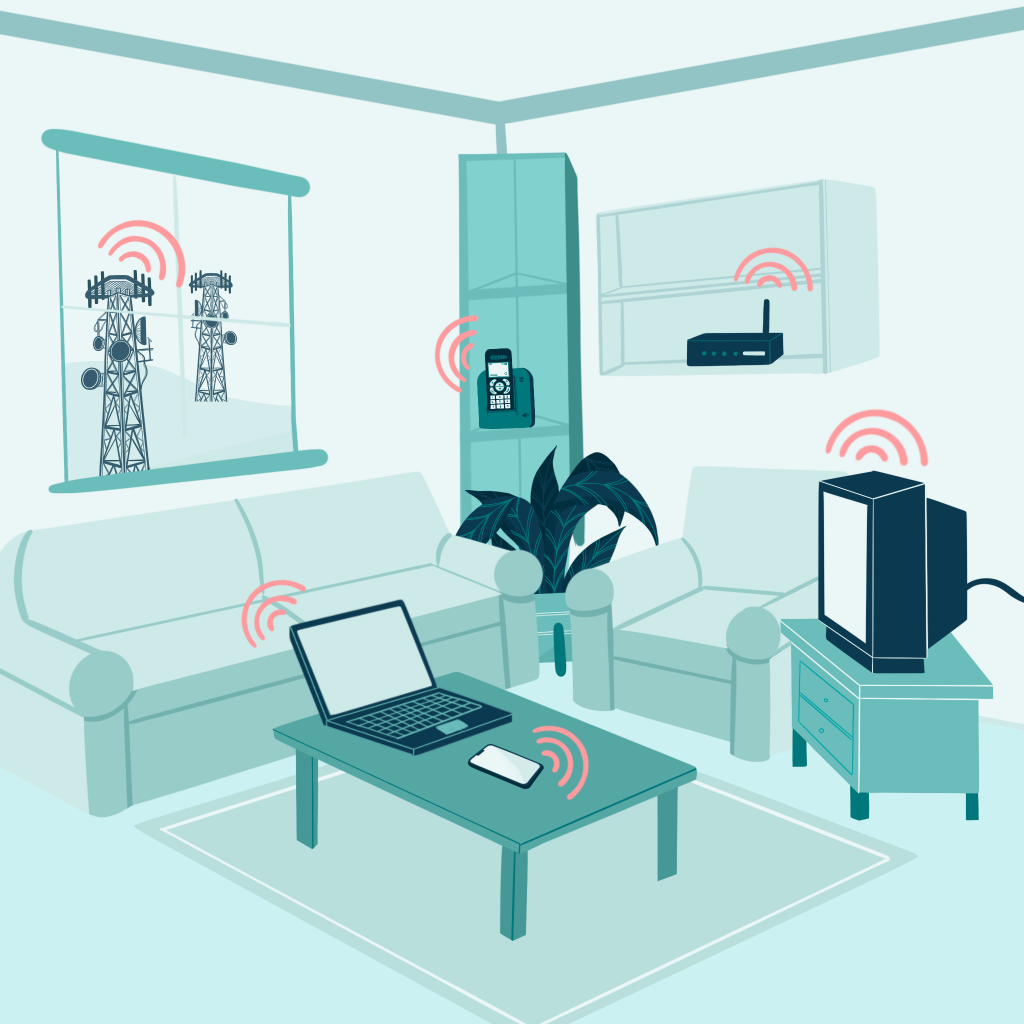
According to the World Health Organization (WHO), Electric fields are created when there is a difference in voltage, while magnetic fields are created when electric current flows.
Electric and magnetic fields (EMFs) are invisible areas of energy, often referred to as Electromagnetic Radiation.
As Electric Current and magnetic field are co-related, all electrical appliances under the electromagnetic spectrum (Radio Waves, Microwaves, Ionizing Radiation) that uses Electromagnetic Wave Frequencies produce Electromagnetic Radiation.
Electronic Radiation is associated with the use of electrical power and sources of Electromagnetic Radiation are from naturally occurring sources and human-made sources.
The two main sources of EMF are Natural Occurring and Human Made. With the advancement in modern technology, most of the EMF we are commonly exposed to, are from Human Made EMF.

Thunderstorms are the most common naturally occurring source of EMF, which is the natural build-up of electric charges in the atmosphere. The compass in the needle always orients in a North-South direction due to the earth’s natural magnetic field. Birds and fish draw on the earth’s magnetic field as navigation when they migrate each year to find more food, pleasant weather, and the perfect place to breed.

EMF is generated whenever an electric current passing through an electronic circuit to perform a function. EMF is found in everyday electrical appliances such as microwave oven, televisions, computers – medical devices such as X rays, defibrillators – and prominently in telecommunications whereby high-frequency radio waves are used to transmit information via antennas, radio stations, and cell phones.
Wavelength and frequency determine another important characteristic of electromagnetic fields. Frequencies with shorter wavelength carry more energy than frequencies with a longer wavelength. EMFs are grouped into two categories based on their frequency – Ionizing and Non-Ionizing.
EMF with short wavelengths carries so much energy capable of breaking bonds between molecules, causing potential harm for cellular and DNA damage. Examples of ionizing radiation can be found in X-rays used in medical therapy, Cosmic rays from the Sun, and Gamma Rays from radioactive decay. The public is warned of the dangers of Ionizing-Radiation and reduce exposure to such radiation as it’s a health hazard to the body.
It is only on a rare occasion we are exposed to ionizing radiation which falls on the far right of the electromagnetic spectrum. People usually do not frequently undergo X-Ray or CT Scans which exposes damage to DNA that can cause cancer.
EMF with longer wavelengths are considered low-level radiation and generally perceived to be harmless to humans. We are more commonly exposed to the Low-Frequency Radiation of Microwaves and Radiowaves.
Commonly used in Telecommunications, Radiowaves are examples of Non-Ionizing Radiation. The energy from RadioFrequency (RF) antennas radiates into space through antennas as electromagnetic waves (radio waves), which are used to transmit data and information into a network of systems.
Microwave ovens channel electromagnetic waves in the form of heat energy which results in a quick and efficient way of heating up food molecules by radiation.
Although non-ionizing radiation is deemed safe, there are many levels to the frequency of the waves.
We are more commonly exposed to the Low-Frequency Radiation of Microwaves and Radiowaves.
Extremely Low-Frequency (ELF) Radiation is considered to be harmless EMF (non-ionizing) as it belongs to the far-left of the Electromagnetic Spectrum. Examples of such ELF are Light Bulbs and power cables with a frequency range of 3 to 30 Hz.
Cell Phones communicate by emitting EMF frequencies, similar to those used for radio and television broadcasts. Cell Phones with 4G network connectivity operate between 700Mhz and 2600Mhz, which falls in the range between "Very High Frequency" to “Ultra High Frequency” in the Electromagnetic Spectrum.
Cell phones are the most applauded breakthrough of modern times. It’s the perfect way to stay connected with others and comes with a sense of security in the event of an emergency.
Modern smartphones are capable of internet access, cellular calls, and come well equipped with GPS technology for navigation. The downside to cell phones is its reliance on network connectivity.
LTE 4G (Long Term Evolution 4th Generation) is the most dominant broadband cellular network, all around the world. In North America, most voice, text, and calls are being handled over 4G networks. Even with the upcoming emergence of 5G network, it would mostly be used by phones to revolutionize download speed but would continue to use 4G networks for data uploads and cellular calls in the foreseeable future.
The four main LTE bands in use in Canada right now are:
Most cell phones don't just connect to one frequency band – they use a combination of low (700Mhz) and high (AWS, or 2600Mhz) to ensure optimum coverage, speed, and location.
Cell Phone Radiation refers to the range of radiowave frequencies that Cell Phone use to communicate with Cellular towers.
The lower the frequency, the longer the signal can travel, but at a slower speed; The higher the frequency, the greater the potential throughput, but at an expense of distance and penetration.
Electromagnetic radiation can be absorbed by organisms, in which it causes a series of physiological and functional changes. Many intricate electrical activities occur in the central nervous system, including learning and memory, which are therefore vulnerable to electromagnetic radiation. By placing the head close to the cell phone during calls, the human brain is exposed to electromagnetic radiation.
Following the enormous increase in cell phone usage, concerns have been raised throughout decades by scientists and researchers to investigate adverse health risks associated with cell phone radiation.
WHO established the International Electromagnetic Fields (EMF) Project in 1996 to assess the scientific evidence of possible adverse health effects from electromagnetic fields.

In 2011, the International Agency for Research on Cancer (IARC) reviewed the carcinogenic potential of radiofrequency fields from cell phones.
Exposure to the human-made Electromagnetic Field (EMF) is inevitable due to the advancement of science and technology. Technological growth is expected to continue; as such, the amount of EMF exposure will continue to increase steadily.
© 2020 DeviceShield Canada. All rights reserved.